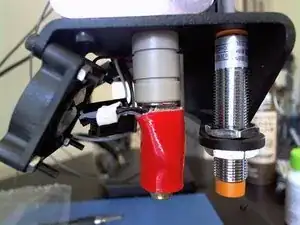
Clearing Jammed Printrbot Simple Metal 2014 Hot End
These are some common tools used to work on this device. You might not need every tool for every procedure.
3D printing, also known as additive manufacturing, is a process that creates three-dimensional objects from digital files by layering material on top of each other. While the first 3D printer was created in the 1980s, it wasn't until the early 2010s that the technology became more accessible and popular.
One of the early pioneers of 3D printing was Hideo Kodama, a Japanese researcher who in 1981 published a paper titled "Automatic Method for Fabricating a Three-dimensional Plastic Model with Photo-hardening Polymer". In his paper, Kodama proposed a method for creating a 3D object by using a photopolymer that solidified when exposed to UV light. Kodama's method used a slicing process to create a series of two-dimensional cross-sections of the object, which were then stacked on top of each other to create a three-dimensional model.
However, Kodama's work was not widely recognized outside of Japan, and it wasn't until the mid-1990s that 3D printing began to gain more attention. In 1986, Chuck Hull, the co-founder of 3D Systems, invented a process called stereolithography, which used a similar photopolymerization process to create 3D objects. This was followed by other methods such as selective laser sintering and fused deposition modeling, which used different materials and techniques to create objects.
Since then, 3D printing technology has continued to evolve, with new materials and methods being developed for a variety of applications, from rapid prototyping to medical implants and even food. The technology has become more affordable and accessible, with desktop 3D printers available for as little as one hundred dollars.
Today, 3D printing is used in a variety of industries, including aerospace, automotive, fashion, and architecture, and has the potential to revolutionize manufacturing and supply chains by enabling on-demand production of custom parts and products.
A 3D printer is a machine that can create physical objects from a digital design by laying down successive layers of material. These machines are also known as additive manufacturing machines because they build objects by adding material layer by layer.
The most commonly used materials for 3D printing are various types of thermoplastics, such as ABS (acrylonitrile-butadiene-styrene), PLA (polylactic acid), PET-G (polyethylene terephthalate glycol), and nylon. Each material has its own unique properties, such as strength, flexibility, and durability, which make it suitable for different types of objects.
Other materials that can be used for 3D printing include metals, ceramics, and even food! However, these materials require specialized printers and are less commonly used in everyday applications.
To create a 3D object, first, you need to design it in a Computer-Aided Design (CAD) program, such as Autodesk Inventor, FreeCAD, or PTC Creo. In these programs, you can create a 3D model of the object, specifying its size, shape, and other details.
Once the design is complete, you need to convert it into a format that the 3D printer can understand. This is typically done using a slicing program, such as Cura or PrusaSlicer. The slicing program takes the 3D model and divides it into thousands of layers, each of which represents a thin slice of the final object. It then generates a set of instructions, called G-code, which the printer uses to build the object layer by layer.
The G-code contains instructions for the printer's movements, including how fast to move, how much material to extrude, and at what temperature to melt the filament. It also controls other aspects of the printing process, such as bed temperature and fan speed.
Once the G-code is generated, you can transfer it to the 3D printer, typically via an SD card or over the network. The printer reads the instructions and begins the printing process, depositing the melted filament layer by layer until the final object is complete.